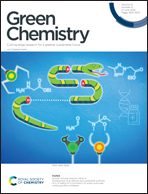Statistical design of experiments for production and purification of vanillin and aminophenols from commercial lignin†
Abstract
Lignin is a complex polyphenolic substance that collectively represents the largest renewable source of aromatic carbon on Earth. Despite low yield and purity from depolymerized lignin, bio-derived vanillin (4-hydroxy-3-methoxybenzaldehyde) is a desirable molecule in the food/beverage and fragrance industries. To maximize vanillin yield from commercially-available softwood lignin, a series of oxidation reactions were conducted using a Box-Behnken statistical design. By varying time, temperature and O2 pressure, optimal conditions were selected using the Response Surface Method, and a maximum vanillin yield of 5.3 wt% was achieved. Flash chromatography of depolymerized lignin was investigated by comparing anion exchange and reversed-phase resins and fractions were characterized by GC-MS, GPC-HPLC, FT-IR and NMR. Anion exchange separations using 1M NaCl as the sole mobile phase reached a vanillin purity of 55 wt %. Lastly, the vanillin mixture was reacted via reductive amination, and facile acid-base work up led to the formation of 4-((diethylamino)methyl)-2-methoxyphenol at 94.3 wt % purity. The aminophenol is an intermediate in the synthesis of pharmaceutical agents, ionic liquids and benzalkonium salts.



 Please wait while we load your content...
Please wait while we load your content...